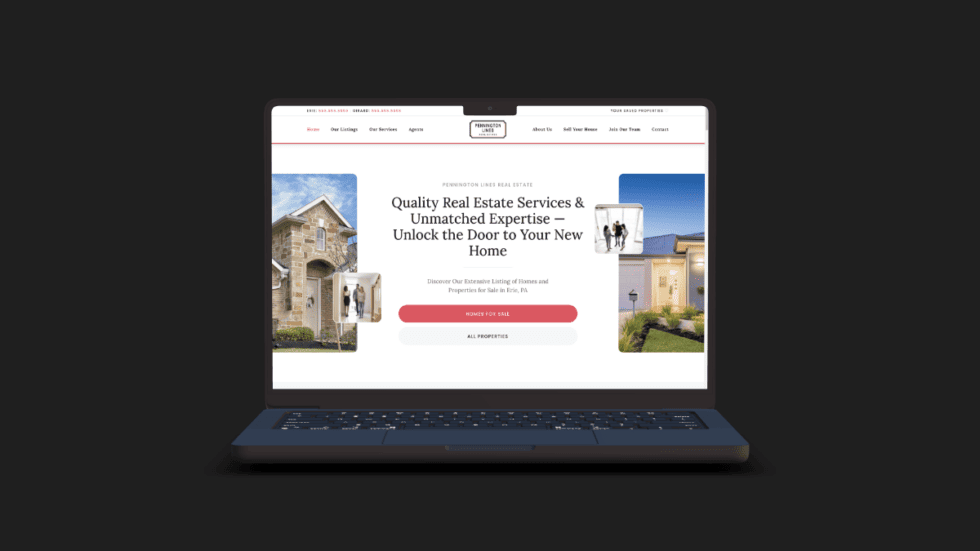
In today’s digital age, having a website is essential for any real estate business. It not only helps you reach a wider audience but also provides your clients with access to valuable information at their fingertips. However, simply having a website isn’t enough; it needs to have quality real estate website design and be optimized to stand out in the crowded online space.
This is where good real estate website design comes into play. In this article, we will discuss a five must-have features list for a real estate website design to attract potential clients and increase conversions. So, let’s dive right in!
Importance of Website Design in the Real Estate Industry
Your website is often the first point of contact for potential clients. It serves as a virtual storefront that showcases your brand and services to the world. The design of your website can make or break a visitor’s impression of your business, affecting their decision to work with you or not.
A well-designed real estate website not only looks professional but also creates a positive user experience and builds trust with potential clients. A good website should be easy to navigate, visually appealing, informative, and optimized for search engines. By incorporating these features into your real estate website design, you can set yourself apart from competitors and attract more leads.
Real Estate Feature List # 1: Easy-To-Use Navigation
A website’s navigation bar is an essential feature for any real estate website design. It refers to a user-friendly and intuitive interface that allows visitors to easily find the information they need. When browsing through a website, users should be able to navigate easily without getting lost or confused.
A simple and organized menu structure with clear labels can make all the difference in providing a positive user experience. A search function is also crucial for those who know exactly what they’re looking for but don’t want to waste time scrolling through pages of listings.
By prioritizing Easy-To-Use Navigation, you’ll ensure that your visitors stay on your site longer, engage more deeply with your content, and ultimately convert into leads or clients.
Importance of Easy-To-Use Navigation for User Experience
Easy navigation is a crucial feature for any real estate website design. It’s important to make it easy for users to find what they are looking for quickly and efficiently. Good navigation can help reduce bounce rates, increase time spent on the site, and lead to more conversions.
A clear menu structure with well-organized categories makes it easier for users to browse through properties or search by specific criteria such as location, price range, property type, etc. A search bar is also essential so that visitors can easily input keywords and find relevant listings. By providing intuitive navigation options, you create a positive user experience which ultimately leads to higher engagement levels on your website.
Examples of Real Estate Website Design with User-Friendly Navigation
Easy navigation is essential for a positive user experience on any website, including real estate sites. Fortunately, there are plenty of great examples out there to draw inspiration from. One such example is Pennington Lines Real Estate’s website, which features clean and simple navigation that allows users to easily find the page they are looking for.
Another excellent example of easy navigation in real estate websites can be found with Pero Real Estate. Their site offers clear categories, making it easy for them to find the information they need without getting lost in a sea of options. By incorporating these elements into your own site real estate website design and ensuring seamless functionality across all devices, you’ll be well on your way toward creating a successful online presence for your business.
Feature 2: Local Expertise
A website that showcases local expertise is crucial for a successful real estate business. This feature enables you to highlight your knowledge of the area where your properties are located, which can help build trust with potential clients. By providing valuable information about the community and its amenities, you demonstrate your authority as a local expert.
Your website should include pages dedicated to each neighborhood or town within your service area. These pages should provide detailed information such as school district boundaries, nearby parks, restaurants, and shopping centers.
The more specific and informative you can be on these pages, the more likely they will attract visitors who may turn into leads or customers.
Importance of Showcasing Local Expertise
When it comes to real estate, buyers and sellers are looking for more than just a property that meets their needs. They want an agent who understands the local market intimately. This is where showcasing local expertise within your real estate website design becomes crucial.
By highlighting your knowledge of the area, you can build trust with potential clients and establish yourself as an authority in the community. Use your real estate website design to showcase neighborhood guides, market reports, and other resources that demonstrate your familiarity with the region. This will help you stand out from competitors who simply list properties without going into detail about what makes each location unique.
Feature 3: Accessibility
One of the essential features that every real estate website must have is accessibility. Accessibility means making your website usable and navigable for all users, regardless of their abilities or disabilities. This feature should be given priority as it ensures that everyone can use your website without any difficulty.
An accessible real estate website design includes features such as clear headings, easy-to-read fonts, alt text for images, etc. It also involves ensuring that the site has proper contrast between background and foreground colors so that those who are color-blind can easily distinguish different elements on your site.
Making these changes will ensure that everyone visiting your website has an equal opportunity to find what they’re looking for quickly and efficiently.
Importance of Accessibility for Different Types of Users
It’s essential to have a website that is accessible for all users, regardless of their abilities. Accessibility means designing your website in a way that accommodates people with visual or hearing impairments, mobility issues, cognitive difficulties, and other disabilities.
By ensuring that the design is inclusive for everyone, you can attract more visitors to your site and make sure they can easily browse through it. Not only does this help increase user satisfaction, but it also enhances search engine optimization by improving user engagement metrics like bounce rates and time spent on the page. Therefore, accessibility should always be a top priority for any real estate website design.
Feature 4: High-Quality Visuals
Potential buyers often make quick judgments based on what they see, and high-quality visuals in your real estate website design can make or break a real estate website’s success. In today’s digital world, it is essential to have visually appealing images that showcase properties in the best possible light. Investing in professional photography and video tours of properties can help convey the look and feel of a property more effectively than written descriptions alone.
In addition to photos and videos, incorporating other visual elements, such as infographics, can also enhance the user experience of your real estate website design. These features not only provide valuable information but also keep visitors engaged with your website for longer periods of time.
Importance of High-Quality Visuals in Your Real Estate Website Design
High-quality visuals are critical in the real estate industry. The right images can make or break a potential buyer’s impression of a property and ultimately affect their decision to buy or not. Having professional photos that showcase every detail of a home included in your real estate website design is essential to attract interested buyers.
In addition to photos, including videos in real estate website design has become increasingly popular in recent years. These tools allow potential buyers to get a better sense of the layout and flow of the property from the comfort of their own homes. High-quality visuals help real estate agents create an emotional connection with potential clients and give them confidence in making an offer on the property.
Examples of Websites with Appealing Visual Elements
One of the most critical elements of a successful real estate website design is high-quality visuals. Stunning images and videos can hook visitors, showcase properties, and convey your brand’s personality. Several websites do an excellent job utilizing visual elements to create an exceptional user experience.
For instance, the Pennington Lines Real Estate website design features beautiful photography to show off homes they are currently selling. On the property pages, there are galleries included to give the potential buyer an in-depth visual tour of the home so they know what to expect before even seeing the home in person.
Feature 5: Lead Generation Tools
When it comes to real estate website design, lead generation is a crucial feature. Lead generation tools help businesses capture potential customers’ information and convert them into leads. These tools can include contact forms, live chat support, call-to-actions (CTAs), and more.
Having effective lead-generation tools on your website can help you grow your business by generating more leads. By making these features prominent in your real estate website design, visitors are more likely to engage with them and provide their information in exchange for relevant content or resources. As a result, this can increase the chances of converting those leads into actual clients for your real estate business.
Importance of Lead Generation Tools in Real Estate Website Design
Lead generation is the backbone of any successful real estate business. For a website in this industry, it’s essential to have effective lead-generation tools that can help them gather relevant information about their potential clients. These tools allow businesses to streamline their workflow and improve their conversion rates.
By providing forms, contact pages, and other interactive elements on your website, you’ll be able to capture leads easily. Additionally, you can use data analytics tools such as Google Analytics or heat mapping software to track user behavior on the site and optimize your strategy accordingly.
With these features in place, you’ll be equipped with valuable insights into what works for your audience and how best to engage them moving forward.
Examples of Websites with Effective Lead-Generation Tools
One of the most critical features a real estate website design must have is effective lead generation tools. These tools enable agents to capture leads and keep them engaged, ultimately leading to more business. Some websites that do this exceptionally well are Pennington Lines Real Estate, Palermo Realty, and Pero Real Estate.
Pennington Lines includes forms directly on the property page, so the user doesn’t need to leave the page in order to contact the realtor. Pero Real Estate has clear calls-to-action strategically placed throughout the site to give potential buyers easy access to contact the business. Clear CTAs and accessible forms are key features to include in any real estate website design.
Conclusion
Having a well-designed website is crucial for any real estate business. By incorporating these five must-have features into your website design, you can improve user experience and increase lead generation.
Easy navigation ensures that users can quickly find what they need on your site while showcasing local expertise helps build trust with potential clients. Prioritizing accessibility allows all users to access your site easily, and high-quality visuals help showcase properties effectively. Effective lead-generation tools are essential for growing your business online.
By implementing these key features in your real estate website design strategy, you will be one step closer to success in the industry! To see how weCreate can help you with your real estate website design, contact us today.


